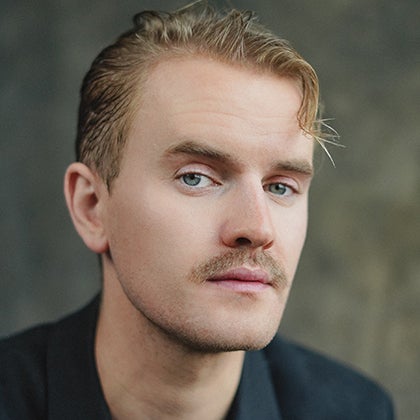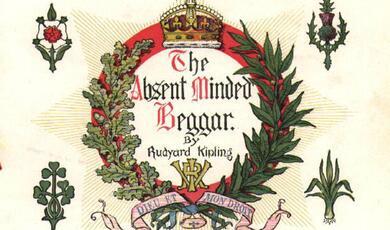The LGBT+ Showstopper: ‘I Am What I Am’
Share
- Details
- Text
- Audio
- Downloads
- Extra Reading
Composed by Jerry Herman of Hello, Dolly! fame, ‘I Am What I Am’ first appeared in the Broadway musical La Cage aux Folles (1983).
As well as gaining importance as a gay anthem during the AIDS crisis, the song has gone on to become a hit for several Black divas including Gloria Gaynor and Shirley Bassey.
This lecture includes live performances by Award Winning West End Actor, Luke Bayer.
Download Text
Showstoppers: I Am What I Am
Dominic Broomfield-McHugh, Visiting Professor of Film and Theatre Music
Thursday 3 April 2025
On Musicals and Representation
In other lectures in this series, I examine ‘Send in the Clowns’, a song written for an actor with limited singing ability, and ‘You’ll Never Walk Alone’, written for an opera singer with considerable vocal ability. But today, I consider the song ‘I Am What I Am’ and reflect on the idea of ‘voice’ from a different point of view: representation (i.e., how a showstopper can give metaphorical voice to a community). According to the OED, early definitions of the word ‘representation’ emphasise ‘the act of evoking the thought or idea of someone’ (1370), an ‘image which stands for a person’ (late 14th century) and the ‘act of playing the part of or imitating someone’ (1538). Another way to think about it might be to think of representation as being about ‘presenting again’, a more intense or fixed copy of someone or something.
The idea of representation often causes controversy in today’s society, and this lecture has not been designed or intended to wade into those current issues, some of which occurred long after the lecture was announced. On the other hand, most of us care what image (in the widest sense) is associated with us, and it’s worth considering for a moment how an image which stands for a person comes with the potential for stereotyping: if only one image or idea has to represent a person’s whole being, it’s difficult for artists completely to avoid leaning into stereotypes that we might recognise. This is especially likely when the image (song, play, film, poem) represents a group—thus creating the need for a more general idea—and even more so when the group is stigmatised or marginalised (because there are already negative social associations with the group). When the group is not involved in constructing the image, that makes it even more difficult for the writer or artist to resist stereotypes because they tend to fall back onto what they think they know of a group to which they may have little connection.
An example from musical theatre: Cole Porter
Sexuality is particularly difficult to engage with in art, because of its combination of feelings and behaviours, so queer representation, with its built-in subjectivity, is especially prone to these issues. It’s worth briefly reflecting on a figure from the world of musical theatre whose sexuality has long been a point of discussion and assumptions: the songwriter Cole Porter (1891-1964), best known for writing the musicals Anything Goes (1934) and Kiss Me, Kate (1948) and songs such as ‘Just One of Those Things’ and ‘Every Time We Say Goodbye’. When I was working with a colleague on The Letters of Cole Porter (published by Yale in 2019), we were fascinated to discover a cache of letters from Porter to the Russian ballet dancer Boris Kochno (1901-90), an associate and lover of the great impresario Serge Diaghilev. Porter and Kochno were travelling separately around Italy, occasionally meeting to have sex. The letters, which are mostly in French, reveal Porter’s desire for and obsession with Kochno:
Letter of 16 September 1925: Porter to Kochno
‘I went to look for a letter at the post office but there was nothing. No doubt you didn’t receive my itinerary in time. But I wait for the next with great impatience.
‘Fortunately I’ve arranged to be in Florence on the 20th and 21st – perhaps the 22nd. I’m sure it will be very difficult to meet but in any case I will have the great luxury to look at those beautiful eyes of which I dream, night and day, my Boris.
‘Goodnight + don’t forget for an instant that I love you.’
Letter of 20 September 1925: Porter to Kochno
‘Maybe this bothers you to tell me such things but that’s what I ask of you. That’s what I dream of.
‘I am so hungry for that – that you tell me you love me + thousands of times so I can read the words you have written during the night when I suffer to have your lips against mine – your lips that I have kissed so often + so tenderly, my Boris.’
Porter’s sexual attraction to men is well known, but has led to reductive, sensationalised biographies. For example, the book Genius and Lust: The Creative and Sexual Lives of Cole Porter and Noel Coward (1995) advertises its subjects thus:
‘They were famous and rich. They set fashion and the rules of sophisticated love. And they did all this for over half a century while keeping their homosexuality a secret. Although their astonishing output was deeply influenced by their sexuality, they feared exposure and went to tragic lengths to hide their true identities.’ (Morella and Mazzei, 1995)
This strain in the reception of Porter’s life and work reaches exaggerated form in Ryan Murphy’s Netflix series Hollywood (2020), which depicts Porter visiting a gas station to receive sexual services from one of the young men working there.
What, then, do we make of the 1946 biopic Night and Day, in which Cole Porter is depicted as happily married to a woman, Linda Lee Thomas (1883-1954)? Clearly, because of the era in which the film was made, Porter’s desire for men could not be depicted at all, but a letter from Porter to his close friend Monty Woolley (who was gay) from the year Porter met his future wife suggests that this may have been more than just a marriage of convenience:
Letter of 25 March 1918: Cole Porter to Monty Woolley
‘With the exception of my occasional soirees [sic] with the half-world, I’m in a complete rut. I lunch and dine with Linda Thomas every day, and between times, call her up on the telephone. She happens to be the most perfect woman in the world and I’m falling so in love with her that I’m attractively triste. It may be merely the Spring, but it looks dangerously like the real thing and I’m quite terrified, for there’s nothing like it to kill concentration.’
The journey from this letter to the salacious and reductive depiction of Porter in his underwear in Hollywood shows why representation is complicated (and also why it matters).
The same year the de-queered Porter appeared on the screen in the form of Cary Grant in Night and Day, Porter’s close friend and colleague Irving Berlin premiered his most successful musical, Annie Get Your Gun. A star vehicle for the great Broadway diva Ethel Merman, the show includes a song for Annie called ‘I Got Lost in His Arms’, describing the process by which the character fell in love. Although written for a woman, this tender representation of falling in love with a man offers a space for queer potentiality, as our performance in the lecture—which does not change a word—demonstrates.
The gestation of La Cage aux Folles
The composer and lyricist of La Cage aux Folles, Jerry Herman (1931-2019), saw Annie Get Your Gun as a teenager and said ‘It changed my life’. He would later write Hello, Dolly! (1964), one of the longest running musicals of the mid twentieth century, with Merman in mind, though she only appeared in it at the end of its long run of over six years. Herman’s career went into the doldrums in the 1970s, but in 1978 he saw a screening of the French film La Cage aux Folles and said ‘That’s a Jerry Herman musical!’ The rights had already been acquired and a creative team engaged but in 1982 the producer Allan Carr approached Herman and invited him to start the project from scratch with a new team consisting of the playwright Harvey Fierstein (b.1952), then famous for writing the gay-themed Torch Song Trilogy, and director Arthur Laurents (1917-2011), well known as the book writer for West Side Story and Gypsy but also experienced as a screenwriter, including of the queer Hitchcock film Rope (1948), starring Laurents’s then-partner Farley Granger (the film was inspired by the Leopold and Loeb case). Fierstein reported that the trio formed the perfect collaboration:
‘I nicknamed Arthur, Jerry, and me “the collaborationists,” considering that this endeavour was subversive. We came from different eras but were united in our aim to see a Broadway audience cheer a man declaring undying ardor to his same-sex partner with a universal love song and a revolutionary kiss. This was the dream we shared.’
Harvey Fierstein, I Was Better Last Night, 152-53
Laurents’s diaries or datebooks at the Library of Congress reveal regular meetings between the three during 1982, mostly at Jerry Herman’s house in New York (he was a gifted interior designer as well as a major songwriter), continuing through the winter into 1983.
Adaptation Theory
The story of La Cage aux Folles involves Georges and Albin, owners of the titular nightclub in St Tropez, where Albin appears in drag as the star Zaza alongside the other performers (known as the Cagelles). Albin and Georges have raised Georges’s biological son Jean-Michel (Laurent in the original play and film) as his parents, but when Jean-Michel comes home to announce he has become engaged to the daughter of the Deputy General of a right-wing morality political party, trouble ensues: Albin is asked not to attend the wedding.
In turning the film and its source play into a musical, Herman, Fierstein and Laurents had to find ways to make it work in a medium for which it was not originally conceived. This calls to mind Linda Hutcheon’s landmark A Theory of Adaptation, in which she writes:
‘To think of narrative adaptation in terms of a story’s fit and its process of mutation or adjustment, through adaptation, to a particular cultural environment is something I find suggestive….[Stories] travel to different cultures and different media.’
Linda Hutcheon, A Theory of Adaptation, 31
To make the story meaningful for a musical, the collaborators considerably expanded the use of performances in the nightclub, which take up less than two minutes of the 1978 non-musical film. On many occasions, Herman described reading part of Fierstein’s first draft of the book for the musical, and asking to use part of the dialogue for the song that become ‘I Am What I Am’. It may be the following excerpt, which I discovered in a draft in Laurents’s papers at the Library of Congress:
ALBIN (still quiet and calm)
I have spent the majority of my life fighting every rule in the book, battling every lesson I was taught, examining, analyzing and reordering everything I was ever told just to find out who I am. I may not be anyone’s idea of what someone would be. But I am me. And I have worked too hard to find out who that is to throw it away now. …
This was Albin’s verbal reaction to being told he could not attend the wedding, and it became ‘I Am What I Am’. But because the song was too big, too much of a performance, and needed to be performed in drag, it could not simply replace that moment in the story, which was the middle of a domestic backstage scene. Therefore, Laurents suggested that there should be a group rendition of the same tune, to less personal lyrics, called ‘We Are What We Are’, to begin the first act. ‘I Am What I Am’ therefore was Albin’s expression of self, performed as an interruption to a reprise of ‘We Are What We Are’ at the end of the first act. In the original production, Albin finished the song, removed his wig, and walked through the audience out of the theatre, creating a loud ovation to go into the interval (the showstopper: the show literally had to stop for a break after such a climax).
Analysing ‘I Am What I Am’
It was openly discussed in the press from the beginning of Herman’s career that he could neither read nor write music. Therefore, he composed at the piano, and some aspects of his songwriting, such as chord structure and the use of vamps, reflect the process of creation. Although there are some limitations to this, the music of the song is powerful, and the gradual build through the number’s multiple refrains in strophic form support the dramatic moment. Nevertheless, the words are particularly impressive. Herman’s papers were sent to the Library of Congress in March 2025 and reveal that just seven pages of handwritten lyrics across all his musicals have survived, but remarkably ‘I Am What I Am’ is one of them. We can see that Herman wrote the song quickly, supporting the story he regularly told that he wrote it overnight, but it actually lacks the climax (‘There’s one life and there’s no return and no deposit / One life, so it’s time to open up your closet’). This is interesting, because the latter might be regarded as the key message of the song – in Italian opera terms, the parola scenica (the equivalent of ‘vincero’ at the end of Puccini’s ‘Nessun dorma’). I’m sure Herman would not have used that term, but it’s a good way to understand that even in a showtune that seems ‘easy’ or simple, there has to be a dramatic arc if it is indeed to stop the show.
The lyric’s combination of words associated with gay culture with phrases implying activism quickly led to it being recorded by artists from other groups – two women of colour (Gloria Gaynor and Shirley Bassey), the lesbian artist Sandra Mihanovich, and the non-binary actor J. Harrison Ghee are just four of the many singers from marginalised groups who have recorded the song. That’s what has helped it to become an anthem: it is both specific to its dramatic moment in La Cage and universal to other social groups. With the advent of AIDS immediately after the opening of the musical, the cultural context solidified the importance of ‘I Am What I Am’ for the queer community. And for Herman, who was diagnosed HIV positive, it made the song and show even more personal.
© Professor Dominic Broomfield-McHugh, 2025
Further Reading
Geoffrey Block, ‘Refashioning Roberta’ in Dominic McHugh (ed.), The Oxford Handbook of Musical Theatre Screen Adaptations, New York, 2019.
Ken Bloom and Jerry Herman, The Lyrics of Jerry Herman, Routledge, 2003.
Stephen Citron, Jerry Herman: Poet of the Showtune, Yale, 2004.
Cliff Eisen and Dominic McHugh, The Letters of Cole Porter, Yale, 2019.
Harvey Fierstein, I Was Better Last Night, Knopf, 2022.
Jerry Herman, Showtune, Dutton, 1996.
Linda Hutcheon, A Theory of Adaptation, Second Edition, Routledge, 2012.
Arthur Laurents, Original Story By, Applause, 2001.
Sheila Whiteley and Jennifer Rycenga, Queering the Popular Pitch, Routledge, 2006.
Primary Sources
All lyric manuscripts shown in the lecture reproduced with permission of the Estate of Jerry Herman, which holds the copyright. The materials from Arthur Laurents’s collection at the Library of Congress are reproduced with the permission of his estate.
Filmography
La Cage aux Folles, 1978
Words and Music By Jerry Herman, 2003
Geoffrey Block, ‘Refashioning Roberta’ in Dominic McHugh (ed.), The Oxford Handbook of Musical Theatre Screen Adaptations, New York, 2019.
Ken Bloom and Jerry Herman, The Lyrics of Jerry Herman, Routledge, 2003.
Stephen Citron, Jerry Herman: Poet of the Showtune, Yale, 2004.
Cliff Eisen and Dominic McHugh, The Letters of Cole Porter, Yale, 2019.
Harvey Fierstein, I Was Better Last Night, Knopf, 2022.
Jerry Herman, Showtune, Dutton, 1996.
Linda Hutcheon, A Theory of Adaptation, Second Edition, Routledge, 2012.
Arthur Laurents, Original Story By, Applause, 2001.
Sheila Whiteley and Jennifer Rycenga, Queering the Popular Pitch, Routledge, 2006.
This event was on Thu, 03 Apr 2025
Support Gresham
Gresham College has offered an outstanding education to the public free of charge for over 400 years. Today, Gresham College plays an important role in fostering a love of learning and a greater understanding of ourselves and the world around us. Your donation will help to widen our reach and to broaden our audience, allowing more people to benefit from a high-quality education from some of the brightest minds.


 Login
Login









